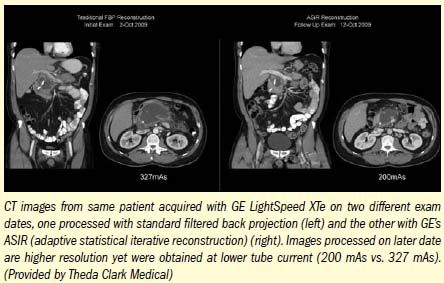Iterative reconstruction's noise reduction capability changes game for CT use
Algorithms that use iterative reconstruction to eliminate noise in images will have a “profound effect” on CT, according to Stanford radiology professor Dr. Geoffrey Rubin.
Algorithms that use iterative reconstruction to eliminate noise in images will have a “profound effect” on CT, according to Stanford radiology professor Dr. Geoffrey Rubin.
“Just about every aspect of image quality and patient safety relating to CT scanning will be impacted in a positive way by iterative reconstruction,” Rubin said.
By using photons more efficiently, iterative reconstruction (IR) algorithms will serve as enabling technologies for advances in image quality and patient safety, allowing radiologists to dial back the kilovoltage (kV) that drives x-ray tubes and the mAs (milliamperes) that define tube current. This can cut patient radiation dose by 50% or more. IR can also be used to better separate the differences in attenuation between calcium and iodine, allowing a reduction in the dose of contrast medium when performing contrast-enhanced CT.

Vendors have either released their own IR algorithms or are preparing to do so:
• GE's ASIR (adaptive statistical IR), commercially released at the end of 2008, is onboard about 350 CTs globally.
• Siemens' IRIS (IR in image space) began shipping commercially in February.
• Philips' iDose, now in beta testing, is scheduled for commercial release before the end of the year (the company is currently taking orders).
• Toshiba's IR algorithm is in FDA review.
Future algorithms that incorporate IR hold out the further prospect of scanning faster and with higher temporal resolution while maintaining image quality. GE is already working on a version of this technology, called MBIR (model-based IR), which is currently in testing at GE luminary sites and will be commercialized later this year outside the U.S. It will not take the place of ASIR, but rather be used on special cases.
Study Shows No Impact of Hormone Therapy on PET/CT with 18F-Piflufolastat in PCa Imaging
May 7th 2025For patients with recurrent or metastatic prostate cancer, new research findings showed no significant difference in the sensitivity of 18F-piflufolastat PET/CT between patients on concurrent hormone therapy and those without hormone therapy.